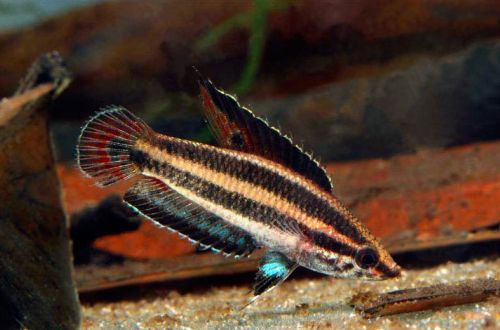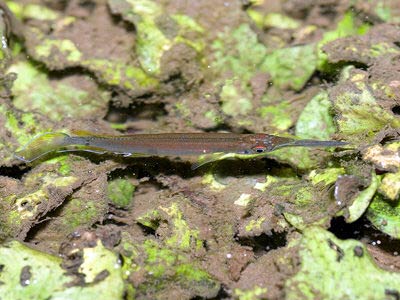
Parosfromenus Alani
Parosfromenus Alani or Kupanus Alani, scientific name Parosphromenus allani, belongs to the Osphronemidae family. Named in honor of the German biologist Allan Brown, who participated in the description of many fish species of the Malay Peninsula. The complexity of the content does not allow us to recommend this species for beginner aquarists.

Contents
Habitat
It comes from Southeast Asia from the Malaysian part of the island of Borneo. The habitat roughly coincides with the territory of the state of Sarawak. Inhabits shallow peat bogs and associated streams and rivers with dense coastal vegetation. The bottom is covered with a layer of fallen plant material (branches, leaves, grass), during the decomposition of which a large amount of humic acids and other tannins are released, from which the water acquires a rich brown color. As humans enter the wild and degradation of natural habitats, fish may well be found in agricultural irrigation canals and roadside ditches.
Brief information:
- The volume of the aquarium – from 30 liters.
- Temperature – 22-28°C
- Value pH — 3.0–6.5
- Water hardness – 1–5 dGH
- Substrate type – any dark
- Lighting – subdued
- Brackish water – no
- Water movement – little or no
- The size of the fish is about 3 cm.
- Food – live or frozen food
- Temperament – peaceful
- Content – in a group of relatives or with other small species
Description
Adult individuals reach a little more than 3 cm. Males differ from females in bright colorful coloring. Their body pattern consists of alternating rows of dark and light horizontal stripes. The fins are black and red, and the edges may contain a turquoise pigment. Some populations lack red hues. The dorsal fin and tail contain an irregularly shaped black spot, a characteristic feature of this species. Females look noticeably more modest. The body pattern is the same, but the fins are ordinary, gray translucent.
Food
The basis of the diet should be live or frozen food, such as brine shrimp, daphnia, bloodworms and similar products. Dry foods are not recommended, fish usually refuse them.
Maintenance and care, arrangement of the aquarium
The optimal size of the aquarium for one or two fish starts from 20-30 liters. The basis of natural design will be natural driftwood, dark soft soil, shade-loving plant varieties, including floating, dried leaves of some trees. Shelters are formed from snags and plants where the fish could hide – it is important when breeding. If decor doesn’t matter, any other decorative items designed for use in aquariums, which can be purchased at any pet store or online, will work as a refuge.
Of key importance in the long-term maintenance of Parosfromenus Alani is the hydrochemical composition of the water. Fish need very acidic and mild pH and dGH. For a novice aquarist, water treatment can be difficult, but maintaining stable water conditions will be no less difficult. To do this, it is necessary to carry out a number of mandatory maintenance procedures, in particular, to replace part of the water with fresh water (10–15% of the volume) weekly, regularly remove organic waste (feed residues, excrement), clean decorative elements, etc.
Being a genus from swampy reservoirs, the fish are not adapted to life in the conditions of the current, the main source of which in the artificial environment is the filtration system. If a small group is kept and there is no threat of overfeeding, then a simple airlift filter with a sponge will suffice.
Behavior and Compatibility
Peaceful disposition, modest size and habitat feature significantly narrow the number of compatible species. For example, small cyprinids, such as rasboras and zebrafish, can become good tankmates. Care should be taken when choosing other Parosfromenus, as many of them are prone to hybridization.
Breeding / breeding
The breeding strategy is as follows. Male and female Kupanus Alani form a temporary pair, which usually spawns in caves on the bottom, among leaf litter and other shelters. The male protects the masonry and the resulting offspring.
With the approach of the breeding season, the male chooses a suitable place for future clutches and begins to protect it from rivals. At the same time, he begins active courtship. When one of the females accepts his signs of attention, spawning occurs, accompanied by mating dances, when the fish are closely pressed against each other, swimming almost vertically head down. Each portion of eggs is picked up and transferred to a shelter, where it is attached to the roof of the cave or placed in a foam-air nest built in advance by the male. At the end of spawning, the female swims away, and the male remains to guard the clutch. The incubation period lasts up to 36 hours. It will take another 4-6 days until the fry begin to swim on their own. From this point on, parental instincts begin to weaken and soon adult fish lose interest in their offspring. Although juveniles can safely be near their parents, there is no guarantee that other fish will not try to eat them, so it is advisable to move the fry to a separate tank with identical water conditions.
Fish diseases
A well-established biological system, a balanced diet and the absence of stressful situations (for example, being chased by aggressive fish) are the best guarantee of maintaining health. When the first signs of an illness appear, first of all, attention should be paid to these three factors, perhaps there was a deviation in one of them. As a rule, solving the problem leads to self-healing. However, if the immune system fails, you will have to resort to medical treatment. Read more about symptoms and treatments in the Aquarium Fish Diseases section.





